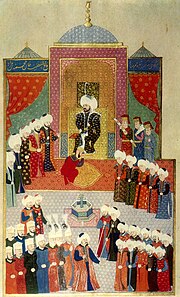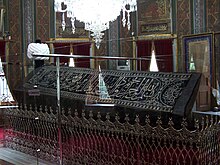Muhammad Al Fatih, The Constantinople Conqueror
Mehmed II, or commonly called as Mehmed The Conqueror or Muhammad Al Fatih, is a king from Ottoman Empire that could conquer Constatinople, that means destroyed the era of Byzantium Empire. Because of his achievements for conquer the most important city in that era and the most powerful kingdom at that era, Mehmed II titled as "The Conqueror".
Mehmed II born 30 March 1432 in Edirne, the capital of Ottoman Empire that time. His father, Sulthan Murad II, is the sixth sultan in Ottoman Empire. When he was 11 years old, he already govern a region, Amasya, part of Ottoman Empire. And his father also often sent many teachers for Mehmed. Islamic education has big impact for little Mehmed.

Coronation of Mehmed II
After Murad II made peace with the Karamanids in Anatolia in August 1444, he abdicated the throne to his 12-year-old son Mehmed II. In Mehmed II's first reign, he defeated the crusade led by John Hunyadi after the Hungarian incursions into his country broke the conditions of the truce Peace of Szeged. Cardinal Julian Cesarini, the representative of the Pope, had convinced the king of Hungary that breaking the truce with Muslims was not a betrayal. At this time Mehmed II asked his father Murad II to reclaim the throne, but Murad II refused. Angry at his father, who had long since retired to a contemplative life in southwestern Anatolia, Mehmed II wrote, "If you are the Sultan, come and lead your armies. If I am the Sultan I hereby order you to come and lead my armies." It was only after receiving this letter that Murad II led the Ottoman army and won the Battle of Varna in 1444.
After his first conquer, he chosed again for two periods of ascending the throne in 1451. He decided to strengthen Ottoman army and expands Ottoman Empire. He planned to conquer Constantinople. Constantinople, is the most important city in the world in that era and the biggest city in Europe, such as New York in this time. Constantinople is a city where the trade route gather.
In the narrow Bosphorus Straits, the fortress Anadoluhisarı had been built by his great-grandfather Bayezid I on the Asian side; Mehmed erected an even stronger fortress called Rumelihisarı on the European side, and thus gained complete control of the strait. Having completed his fortresses, Mehmed proceeded to levy a toll on ships passing within reach of their cannon. A Venetian vessel ignoring signals to stop was sunk with a single shot and all the surviving sailors beheaded, except for the captain, who was impaled and mounted as a human scarecrow as a warning to further sailors on the strait.
Abu Ayyub al-Ansari, the companion and standard bearer of Muhammad, had died during the first Siege of Constantinople (674–678). As Mehmed II's army approached Constantinople, Mehmed's sheikh Akshamsaddin discovered the tomb of Abu Ayyub al-Ansari. After the conquest, Mehmed built Eyüp Sultan Mosque at the site to emphasize the importance of the conquest to the Islamic world and highlight his role as ghazi.
In 1453 Mehmed commenced the siege of Constantinople with an army between 80,000 and 200,000 troops, an artillery train of over seventy large field pieces, and a navy of 320 vessels, the bulk of them transports and storeships. The city was surrounded by sea and land; the fleet at the entrance of the Bosphorus stretched from shore to shore in the form of a crescent, to intercept or repel any assistance for Constantinople from the sea. In early April, the Siege of Constantinople began. At first, the city's walls held off the Turks, even though Mehmed's army used the new bombard designed by Orban, a giant cannon similar to the Dardanelles Gun. The harbour of the Golden Horn was blocked by a boom chain and defended by twenty-eight warships.

Paint by Fausto Zenaro that illustrate the entry of Muhammad Al Fatih when entering Constatinople
On 22 April, Mehmed transported his lighter warships overland, around the Genoese colony of Galata, and into the Golden Horn's northern shore; eighty galleys were transported from the Bosphorus after paving a route, little over one mile, with wood. Thus the Byzantines stretched their troops over a longer portion of the walls. About a month later, Constantinople fell, on 29 May, following a fifty-seven-day siege. After this conquest, Mehmed moved the Ottoman capital from Adrianople to Constantinople.


Ottoman Empire territory, in Mehmed II first reign and before he died.
After conquer Constantinople, Mehmed II again conquering many region and kingdom, such as Serbia, Bosnia, Morea, Black Sea coast, and tried to conquest Wallachia. When war against Wallachia that led by Vlad III, night attack where many Ottoman army killed cruelly by Vlad III. Then, Ottoman take back the army from that operations.
Besides that, many wars and others conquests that led by Mehmed II, some of them succeed, and others failed. Mehmed II make the territory of Ottoman Empire became very large.

The tomb of Mehmed II
In 1481 Mehmed marched with the Ottoman army, but upon reaching Maltepe, Istanbul he became ill. He was just beginning new campaigns to capture Rhodes and southern Italy, however according to some historians his next voyage was planned to overthrow the Mamluk Sultanate of Egypt and to capture Egypt and claim the caliphate. But after some days he died, on 3 May 1481, at the age of forty-nine, and was buried in his türbe in the cemetery within the Fatih Mosque Complex. According to the historian Colin Heywood, "there is substantial circumstantial evidence that Mehmed was poisoned, possibly at the behest of his eldest son and successor, Bayezid."
Mehmed II is a king that wise and smart, but never being arrogant. Although he always doing war to another country, he never doing or instruct to do cruelty to the region that he conquer. Mehmed II also have leadership from he was 11 years old, and can speak many language such as Arabic, Greek, Latin, etc. He lead Ottoman Empire wisely and love justice.


Question related :
1. Where and when Muhammad al Fatih born?
2. When Muhammad al Fatih started lead a wide province?
3. What is the most popular conquer that led by him?
4. When is Muhammad al Fatih dead?
5. Who is Muhammad al Fatih's father? And what empire that he led?
Source :
1. Where and when Muhammad al Fatih born?
2. When Muhammad al Fatih started lead a wide province?
3. What is the most popular conquer that led by him?
4. When is Muhammad al Fatih dead?
5. Who is Muhammad al Fatih's father? And what empire that he led?
Source :
https://id.wikipedia.org/wiki/Mehmed_II
Powerpoint
https://drive.google.com/open?id=11dArYsYEqrt1WH2ZYH4sZfcImh8j-0bK
https://docs.google.com/presentation/d/11dArYsYEqrt1WH2ZYH4sZfcImh8j-0bK/edit#slide=id.p1
Powerpoint
https://drive.google.com/open?id=11dArYsYEqrt1WH2ZYH4sZfcImh8j-0bK
https://docs.google.com/presentation/d/11dArYsYEqrt1WH2ZYH4sZfcImh8j-0bK/edit#slide=id.p1


Comments
Post a Comment